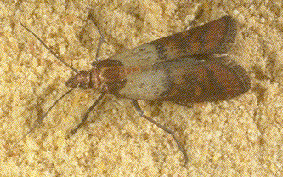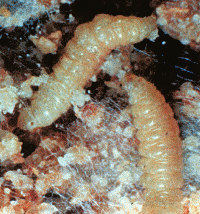Insect Pests of Stored Grain: Indianmeal Moth
ENTFACT-136: Insect Pests of Stored Grain: Indianmeal Moth | Download PDF
Plodia interpunctella (Lepidoptera:Pyralidae)
by Doug Johnson, Extension Entomologist
University of Kentucky College of Agriculture
Damage
Indianmeal moth larvae are secondary pests, which means that they prefer to feed on fines or damaged kernels. Infestations are most common in the upper four to six inches of grain in a bin. They become active in early spring because surface grain is usually the first to warm. The larvae produce silken threads which result in "caking" or "crusting" of the surface grain. Their frass (waste), cast exoskeletons (exterior skin-like covering) and silk contaminate the grain.
Description
Indianmeal moths (pictured right) rest with their wings folded over their backs. They are about 0.4 inch long with a wingspan of about 0.6 inch. The outer portion of the front pair of wings is coppery; however, this color may be lost as the moth loses its scales. The inner half of the wing near the body is light gray. The hind wings are gray with no distinctive markings. The larval or feeding stage is a caterpillar (shown below right) that may range from yellow-white to pink to light green with a light brown head. Full grown larvae are about 0.7 inch long.
Biology
Female moths deposit from 60 to 300 eggs, singly or in groups on or within the upper surface of the grain mass. The larvae move about in the upper grain mass, feeding on fines and cracked kernels and producing a silken webbing. Full grown caterpillars may leave their food source and climb up walls to pupate. The life cycle from egg to adult takes about six to eight weeks during warm weather. There are usually four to six generations per year depending on food supply and temperature conditions.
Control
Prevention is always the most economical and efficient method of controlling these pests. However, because infestations are usually limited to the top few inches of grain, control can be obtained without fumigation. Producers need to remove the surface crust and spoiled grain. The exposed grain surface then can be treated with an approved insecticide. If available, " No Pest" strips containing dichlorvos can be hung in the head space to aid in preventing an infestation. However, registration of this product may soon end and the strips are very difficult to find.
For specific insecticide recommendations for individual crops see:
- Corn, Field - Insecticides for Corn, ENT-16
- Popcorn - Insecticide Recommendations for Popcorn - ENT-62
- Sorghum - Insecticide Recommendations for Sorghum (Milo) - ENT-24
- Soybeans - Insecticide Recommendations for Soybeans - ENT-13
- Wheat - Insecticide Recommendations for Small Grains - ENT-47
These publications are available at local county extension offices in Kentucky.
Issued: 8/00
Revised: 7/09
CAUTION! Pesticide recommendations in this publication are registered for use in Kentucky, USA ONLY! The use of some products may not be legal in your state or country. Please check with your local county agent or regulatory official before using any pesticide mentioned in this publication.
Of course, ALWAYS READ AND FOLLOW LABEL DIRECTIONS FOR SAFE USE OF ANY PESTICIDE!
Photos: Ric Bessin, University of Kentucky Entomology and USDA Insect and Plant Disease Slide Set


